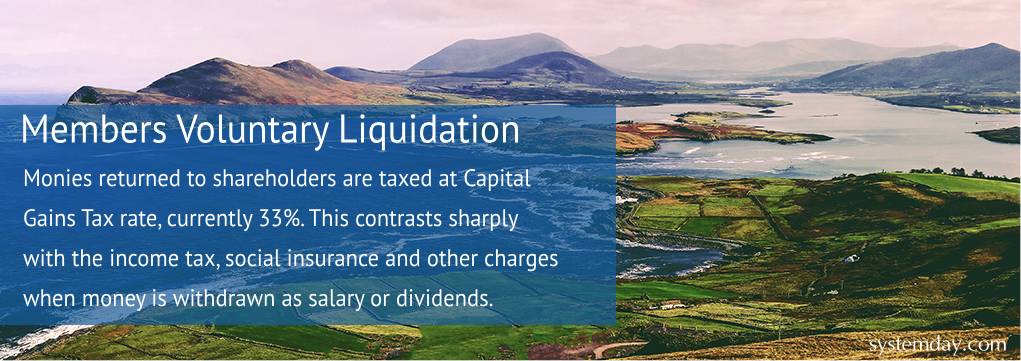
Members Voluntary Liquidation
Shareholders and Members Voluntary Liquidation
Shareholders would conduct an ‘MVL’ where:
- The company had come to the end of its useful life and was no longer needed
- The Directors/Shareholders want to retire and there are no successors or third parties to purchase the business
- The Directors/Shareholders have fallen out and the business cannot continue.
Tax treatment of funds received
A further incentive to wind down a down a company is the fact any funds returned to shareholders are taxed at Capital Gains Tax rates (currently 33%). This contrasts sharply with the amount of income tax + social insurance and charge which is applied when money is withdrawn as salary or dividends.
Certain assets, including property, held by the Company, can also be distributed ‘in specie’ that is in kind in an MVL to shareholders and no stamp duty is payable (subject to having no mortgage or outstanding debt.)
How a Members Voluntary Liquidation proceeds
A Members Voluntary Winding Up would proceed as follows.
- The Directors complete a Summary Approval Procedure, which must:
- Be made in writing
- Be executed by all or a majority of directors
- Be executed a meeting held not earlier than 30 days before the shareholders meeting
- State the amount of current assets and liabilities
- State That the company will be able to pay its debts in full within 12 months of commencement of winding up
- Be accompanied by an ‘Independent Person’s Report’ which states the Directors are ‘not unreasonable’ in stating the assets and liabilities. (The Independent Person is a person qualified to be it auditor)
- The Directors then call Extra Ordinary General Meeting of Members of members to pass Special Resolutions to wind up company and appoint Liquidator. A copy of the Summary Approval Procedure
- The Liquidator must indicate his/her willingness to become Liquidator by completing a Consent to Act, in writing
- Meeting of Members (EGM) to pass Special Resolutions. This meeting may be held at Short Notice, provided all the Members consent, and may be held on the same day of the meeting of directors.
- This may also be done by way of Written Resolution of members
- Filing of Forms in Companies Registration Office to commence the liquidation. (Summary Approval Procedure/Declaration of Solvency – Special Resolution – Appointment of Liquidator)
- Publication of Notice in Iris Ofiguil
- Liquidator proceeds with the winding up, which must be concluded with twelve months.
- This includes obtaining tax clearance from the Revenue Commissioners
- Liquidator calls Final Meeting of Members, to give a final account (28 days’ Notice Required)
- Final Meeting of Members held
- Liquidator submits final forms, within seven days, to Companies Registration Office to finish the liquidation.
- CRO dissolve the company three months later.
Liquidators Role
Once appointed the liquidator will usually take most of the following:
- Find, protect and realise all remaining assets, which could involve taking possession of keys of premises, changing locks etc., notifying insurance companies of the change in status of the company and having his/her interest noted on the policy.
- Contacts the Company’s bank notifying them of the fact that the company has gone into liquidation and changes mandates on all bank accounts
- Contacts the Collector General & Local Tax Office to ascertain the tax position of company
- Collects any outstanding debts due to the Company
- Ensures that all creditors have been paid in full
- Distributes any surplus funds or assets to members
- Completes all statutory obligations imposed by the Companies Act in relation to a Members Voluntary Winding Up
Typical fees
As a guide the fees for the liquidation of a company which has been brought to a position where there are no liabilities and only cash in the bank to be distributed would be €5000.
Liquidators fee €2500
Independant Accountants Report (an Auditor) to accompany the Declaration of Solvency is required €600
Outlays for advertising, registry filing fees €400
Once all liabilities are up to date with the Revenue, Tax Clearance is applied for and once received the distribution to shareholders can be made. The liquidator can give an interim distribution after 2 weeks or so while awaiting Tax Clearance if required. Revenue clearance can take from 3 to 4 months.
